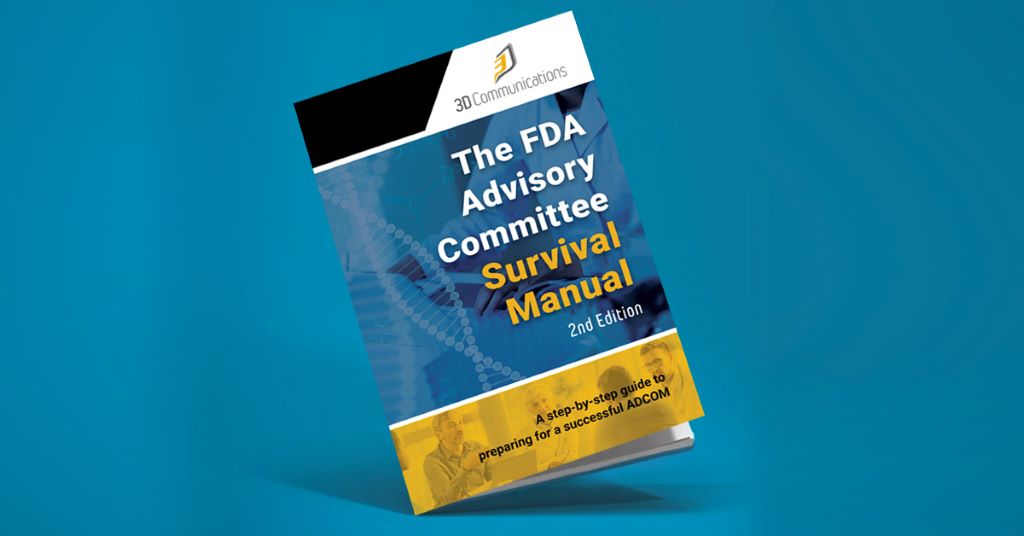The FDA Survival Manual – A Step-by-Step Guide to Preparing for a Successful ADCOM, 2nd Edition

To purchase a copy of The FDA Survival Manual – A Step-by-Step Guide to Preparing for a Successful ADCOM, 2nd Edition, please visit the Regulatory Affairs Professional Society’s (RAPS) e-library here.
_________________
Review by Meredith Brown-Tuttle, RAC, FRAPS
“The FDA Advisory Committee Survival Manual, 2nd Edition” is an expanded step-by-step guide designed to help pharma, biotech, and medical device companies prepare for and succeed at FDA advisory committee meetings (ADCOMs). This latest edition outlines the pragmatic approach and processes that 3D Communications developed and refined from nearly 500 ADCOMs over the last 20+ years. It now features additional insights, tools, and guidance on everything from developing on-target and clear presentations and managing difficult questions, to leveraging technology and handling meeting-day logistics and communications.
I reviewed the first edition book when it came out in 2008 and used it extensively. The second edition has captured the evolution of the Advisory Committee (ADCOM) process since the last edition; it has been updated and expanded with even more helpful tools to help you navigate ADCOM meetings and planning.
As with the first edition, the book is full of color and diagrams and is easy to read. The book itself is broken down by topics, including:
-
Analysis
-
Content development
-
Testing and training
-
Final preparation and meeting execution
-
Closing and logistics
The entire preparation process for ADCOM meetings—strategy, developing the meeting briefing package, writing the script and subsequent slides, organizing the slides, managing the slides process, dealing with the media, and rehearsals—is described (even the sponsor’s back room and food service at the FDA is covered). Other highlights include how to:
-
Assemble the right team to develop the content and prepare for the mock rehearsals and real ADCOM
-
Gather intelligence on ADCOM members and anticipate questions they could ask
-
Leverage tools for positive media interactions
There is even a “how-to” section and summary of key takeaways at the end of each chapter.
There are only a handful of consulting firms that support and help prepare companies for ADCOM meetings--and 3D Communications has set itself apart with this practical manual that provides an overview of the preparation process and “how-to” tips. To write simply—using brevity, lots of white space, and color—while imbuing the reader with the “how-to” of ADCOM meetings, shows true mastery of knowledge that only comes from years of practice and experience that these authors clearly have.
Additions to the second edition include:
-
Updated background on ADCOMs. Discussion of potential reforms of ADCOM practices and different FDA interactions before, during, and after an ADCOM.
-
New templates and tools for content creation, with guidance on who and when. Further improve clarity and message consistency when delivering a presentation or answering questions. These new processes include the full Key Message Grid, the Elevator Speech, the Q&A Road Map, (with examples of how NOT to answer), the Objection Handler, and the Message Review and Alignment process.
-
Slides for the presentation and backup. More examples throughout the book, including additional “before and after” slides highlighting the dos and don’ts.
-
Virtual/hybrid ADCOMs. Detailed information on how to prepare teams for the possibility of virtual or hybrid advisory committee meetings.
New chapters include:
-
Engage Stakeholders. Integrating Impactful Perspectives into the Advisory Committee Process. This is now completely focused on the Open Public Hearing and guidelines around it.
-
Check It. Check It Again. Conducting Quality Control at the Right Time with the Right People. The focus here is how to ensure quality control of the data in the presentation, backup slides, and the briefing document.
-
Speak to the Street. Working with the Investment Community. This includes who should be speaking, when, and how to coordinate with the regulatory team.
The take home message? Be clear, honest, organized, and brief in all communications. This book did exactly that. I would recommend this book to regulatory professionals who would like a general overview and understanding of the ADCOM process, with tips to get started quickly.
Meredith Brown-Tuttle, RAC, FRAPS, is the Chief Regulatory Strategist for Regulatorium, author of “IND Submissions: A Primer” and “Regulatory Intelligence 101” (1st and 2nd editions) and likes living on the cutting edge of regulatory intelligence and strategy tool development. She can be reached at theregulatorium@gmail.com.